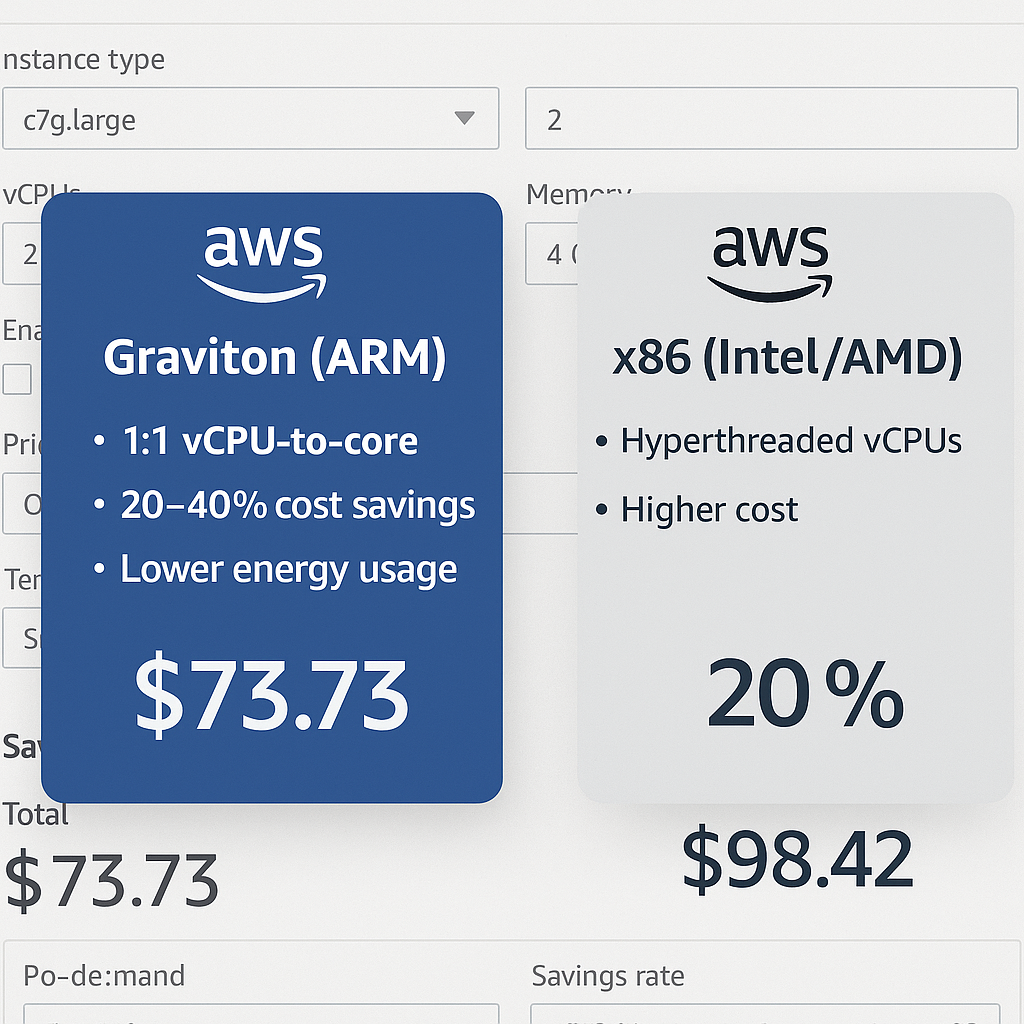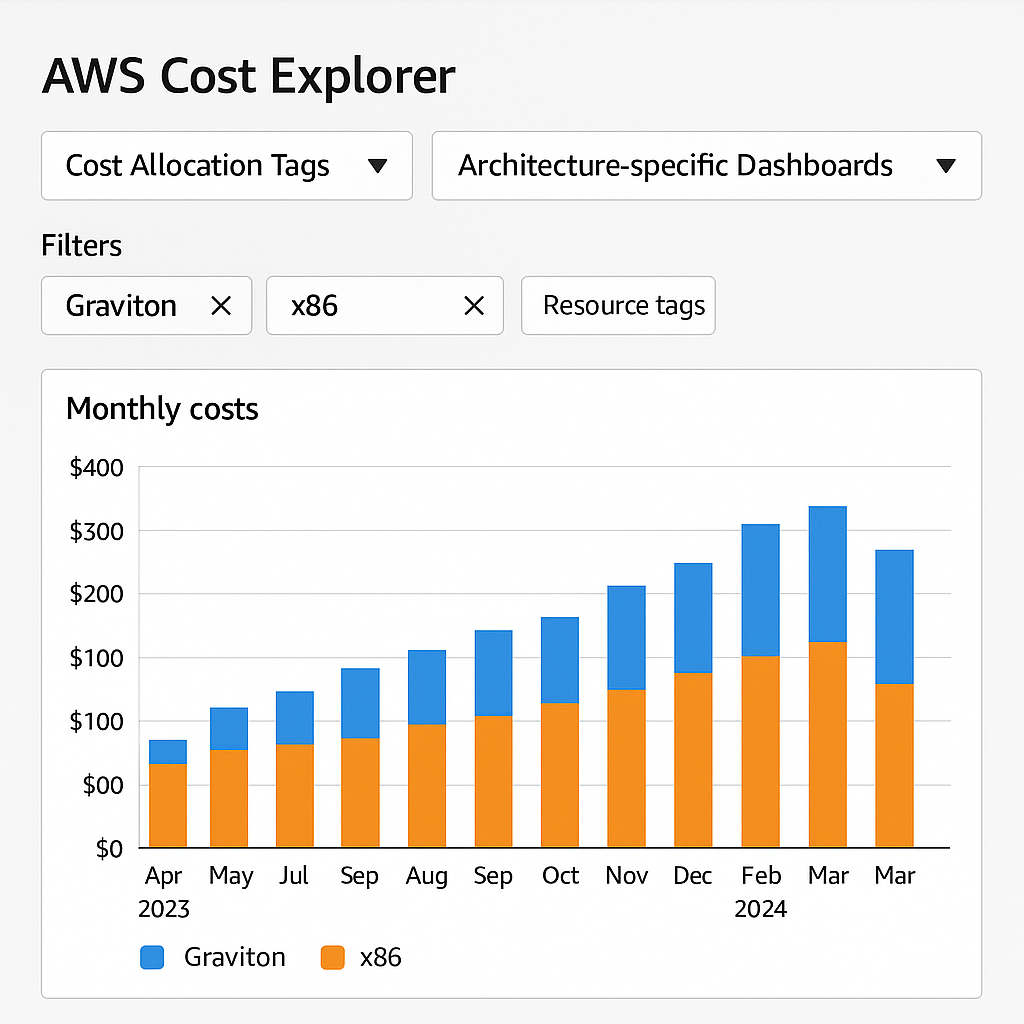Integrating AWS Graviton instances with AWS cost savings calculators
Have you been considering AWS Graviton instances for your workloads but aren’t sure how to accurately calculate the potential cost benefits? You’re not alone. While AWS claims Graviton instances can deliver up to 40% better price-performance compared to traditional x86 instances, translating that into actual savings requires proper integration with AWS cost tools and careful planning.
Understanding Graviton’s cost efficiency profile
AWS Graviton processors are ARM-based custom silicon designed specifically for cloud workloads. Their fundamental architecture provides several cost advantages compared to Intel and AMD x86 instances:

- 20-40% cost savings for compute workloads compared to Intel/AMD alternatives
- Lower power consumption - up to 60% less energy usage
- 1:1 vCPU-to-core mapping - unlike x86 processors that use hyperthreading
This architectural difference is crucial when integrating with AWS cost calculators, as it affects how you should size and estimate workload requirements.
Integrating Graviton with AWS cost savings calculators
AWS Pricing Calculator and TCO Calculator
When using AWS’s official cost calculators to estimate Graviton savings:
-
Adjust core-to-workload mapping: Since Graviton maps 1 vCPU to 1 physical core (no hyperthreading), you’ll need different instance sizes than x86 equivalents.
-
Use realistic workload profiles: Input your actual workload characteristics into the calculator, focusing on multi-threaded, ARM-compatible tasks where Graviton excels.
-
Compare instance families strategically: When comparing costs, match Graviton instances against their equivalent x86 options (e.g., C7g vs. C7i).
For example, a C7g.large Graviton3 instance costs approximately $55/month, while an Intel Sapphire Rapids-based C7i.large runs about $67.55/month - an immediate 18.5% savings before even considering performance benefits.
AWS Cost Explorer integration
When analyzing Graviton cost efficiency through Cost Explorer:
- Create resource tags specifically for tracking Graviton vs. x86 instances
- Set up custom cost allocation tags to attribute costs accurately
- Configure Cost Explorer views that compare architecture-specific costs
This approach helps track actual cost differences over time rather than relying solely on theoretical estimates.

Graviton sizing recommendations for maximum cost efficiency
Selecting the right Graviton instance size is crucial for optimizing cost benefits:
Workload-specific sizing guidance
- Compute-intensive workloads: C7g instances offer 25% better computational performance at 30% lower cost compared to x86 C5 instances
- Memory-intensive applications: R7g instances excel for database workloads requiring high memory bandwidth
- General-purpose needs: M7g instances provide balanced compute/memory performance
Right-sizing considerations
When migrating from x86 to Graviton, avoid direct size matching. Instead:
- Analyze actual resource utilization of your current x86 instances
- Consider Graviton’s core efficiency - you may need fewer vCPUs than your current x86 instance
- Test with various instance sizes before finalizing
As one performance comparison between Graviton and Intel instances found, an example compute workload costs approximately $91,000 annually on Graviton compared to $108,000 on AMD and $182,000 on Intel - potentially cutting costs in half compared to Intel.
Maximizing savings with Graviton deployment strategies
Beyond simple instance selection, several strategies can further enhance cost efficiency:
1. Prioritize workloads by ARM compatibility
Begin with workloads that are natively ARM-compatible to avoid performance penalties. According to the compatibility of software with AWS Graviton, the best candidates include:
- Containerized applications
- Java, Python, Node.js, and Go applications
- Linux-based workloads (Amazon Linux 2, Ubuntu 20.04+, RHEL 8+)
2. Leverage spot instance pricing
Graviton Spot instances offer even deeper discounts - a C7g.large spot instance costs approximately $24.10/month compared to higher x86 spot prices.
3. Combine with Savings Plans
Pairing Graviton instances with AWS Savings Plans can compound your savings:
Base Graviton savings (~30%) + Savings Plans discount (up to 72%) = Maximum cost efficiency4. Target CI/CD pipelines first
CI/CD workloads typically show dramatic cost improvements on Graviton. According to Tom’s Hardware benchmarks, Graviton4 reduces compilation costs by approximately 35% compared to Intel/AMD alternatives, with benchmarks showing Gem5 compilation at $0.186/run on Graviton4 versus $0.288 on AMD and $0.194 on Intel.
Implementing best practices for cost monitoring
To ensure you’re maximizing Graviton savings over time:
1. Establish performance baselines
Before migrating, document your current x86 instance performance metrics to verify that Graviton instances maintain or improve performance at lower cost.
2. Implement automated cost monitoring
Tools like Hykell can provide automated cloud cost optimization, ensuring your Graviton instances remain properly sized as workloads evolve. This approach can yield up to 40% savings through dynamic adjustments without requiring constant manual effort.
3. Create architecture-specific dashboards
Develop CloudWatch dashboards that specifically track Graviton performance metrics alongside cost data to maintain visibility into your price-performance ratio.
Graviton migration planning for cost optimization
When planning your migration to Graviton for cost savings:
- Start with test environments to validate compatibility and performance
- Use phased migration approaches as outlined in the migrating applications to Graviton instances guide
- Develop architecture-specific cost allocation to track actual savings
- Implement best practices for Graviton instances to ensure optimal performance
Common pitfalls to avoid
When calculating Graviton cost savings, watch out for these common mistakes:
- Ignoring ARM compatibility requirements - some workloads may need refactoring
- Overlooking single-threaded performance needs - Intel/AMD may outperform Graviton for these specific tasks
- Using incorrect vCPU equivalence - due to the hyperthreading difference
- Forgetting to validate performance - cost savings are meaningless if performance suffers
Real-world cost efficiency examples
Numerous organizations have achieved significant savings through Graviton adoption:
- A financial services company reduced costs by 35% by migrating PostgreSQL databases to Graviton3 while maintaining query performance
- A media company improved video encoding speed by 73% on Graviton4 while reducing costs by 35%
- For HPC workloads, benchmarks show Graviton4 outperforming both AMD Genoa and Intel Sapphire Rapids in benchmarks like Blender 4.0.2 and 7-Zip compression while maintaining lower costs
- GOV.UK saved 15% per instance migrating from m6i (x86) to m7g (Graviton)
Conclusion
Integrating AWS Graviton instances with AWS cost savings calculators requires understanding the architectural differences, properly sizing workloads, and implementing careful monitoring. When done correctly, organizations consistently achieve 20-40% cost savings while maintaining or improving performance.
To maximize your AWS cost optimization, consider using automated tools like Hykell that continuously analyze your environment for Graviton migration opportunities and provide ongoing optimization. With the right approach, Graviton instances can significantly reduce your AWS compute costs without sacrificing performance or reliability.
